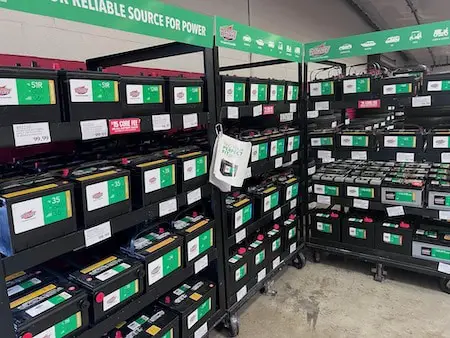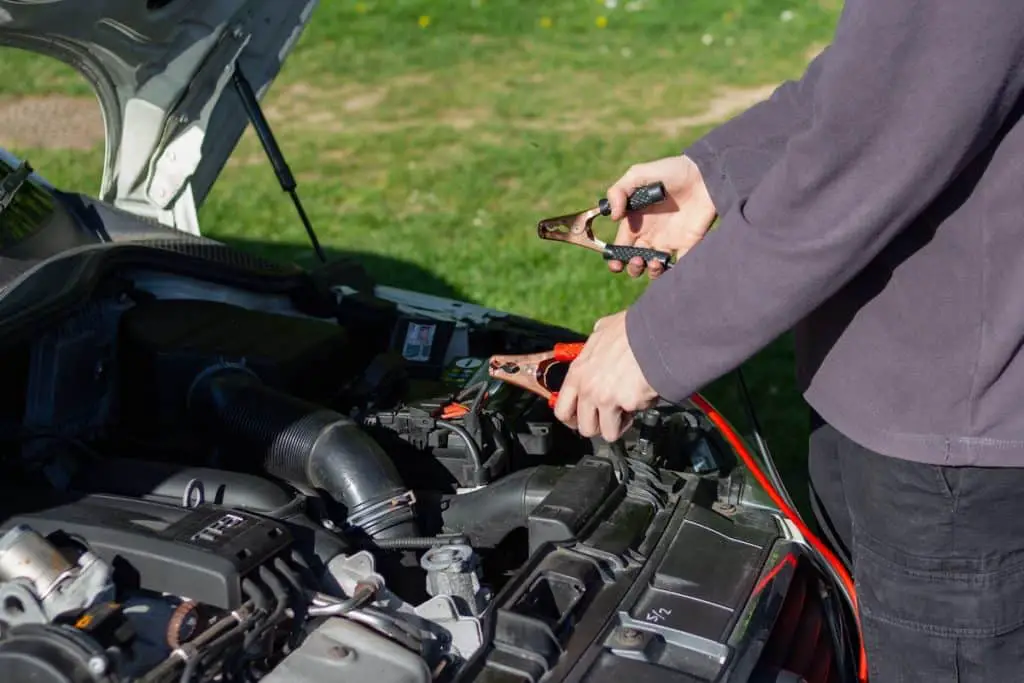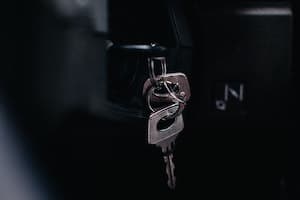1. How to Start My Car with a Low Battery
If you know that your battery is weak before you try to start your car, ensure that everything inside the car is powered off. Turning off everything possible will ensure all battery power can go towards turning the starter motor.
- Modern cars have headlights that turn on immediately when you insert the key and turn the key part way. Your headlight control switch should have an “off” position that will over-ride the “auto-on” function, which will keep the lights off when you try to start the car.
- Keep your foot off the brake pedal, so your brake lights won’t drain the battery
- Also turn off your radio, heater and/or air conditioner.
Start your car with a low battery ensuring that everything in the car is powered off to reduce the power draw from the car. Make sure the battery is clean and securely connected. If the car will not start after these efforts, you must jumpstart the car with the help of another car battery.
As a last ditch effort to starting a car that is running low on battery, after turning off all accessories, try talking nicely to your car to get it to start. Say nice things to it and maybe promise a fresh oil change and a good wax job or something if the car is good to you. Cars can sense when you are going to follow through with your promises though so make sure it is sincere. Then crank away! Hopefully the sweet talking will make a difference. If not, you need a jump or a tow!
I treat my car well and she treats me well in return
Jake E.
2. Can I drive my car with a low or bad battery?
A car is fully capable of operating with a battery that is not fully charged as long as the alternator is working well enough to perform it’s function of charging the battery. While the car is running, the alternator charges the battery and the battery in turn provides power to the lights and ignition system.
If a car battery is low, then the most difficult part will be to get the car started. Generally if the battery is below 12.4 volts, it is not going to be able to start the car.
Generally if the battery is not so dead to still be able to be jump-started, you will be able to drive the battery for a little while longer.
If a battery is not holding a charge, but you can get the car started, it is possible to run the car and drive to your destination, but do not shut off the car along the way for it may not start again since it is not holding sufficient charge. And you should replace the battery as soon as possible!
Pro Tip: Buy your car batteries from Costco! They have the best deals on car batteries.

3. Unsure if it is my Battery, Starter, or Alternator with a Problem
How do I tell if it is my battery, alternator, or starter preventing my car from starting?
Battery
If the battery is bad, it will not hold a charge between 12.6 and 12.8 volts
This may be caused simply by the age of the battery. The way lead acid batteries are designed, over time they slowly lose their ability to hold a charge due to the chemical reactions that are occurring in the battery which are what produce the electricity.
This natural process may have been sped up by either the climate that the battery has been in or by the way the battery has been stored if it was not in use for a period of time.
Extreme cold and hot weather cause a battery to go bad faster. Repeated deep cycling of a lead acid battery will also cause a battery to wear out faster. Car batteries are not designed to drain very low and a battery tender should be used to keep the battery voltage topped off.
Starter
You can tell the starter is bad if the battery is charged, securely connected, and if the starter will not turn when a voltage is applied directly to the starter.
This is a quite simple test although most often done after inspecting the battery, cable connections, and the alternator.
Once you have done those tests, you can move on to the starter voltage test. Simply run a wire from the positive terminal of the battery to the positive terminal of the starter. Only touch the wire on the starter positive lead for a second or two. If the starter engages, it is good. Otherwise, it has an issue!
The battery solenoid is a common culprit for starter issues however and should be tested as well.
No joke, the test for the starter solenoid if your car won’t start:
If the car is not making any sound when you turn the key and the battery is charged, the solenoid may be stuck. Rap on the side of the starter with a hammer to unstick the solenoid. The solenoid is most often housed in a cylinder attached to the side of the starter. If the car fires up after that, you know the solenoid is sticking and should be replaced.
Alternator
If the alternator is bad, the battery will read less than 13.5 volts while the car is running.
That is simply it.
If the voltage reads below 13.5 volts then the alternator is bad.
If the voltage reads at or above 13.5 volts then the alternator is good.
The best way to test this is to use a multimeter and check the voltage at the battery while the car is running. If the voltage is low, then the alternator is not generating as much power as it should and should be replaced.
Of course there are components in the alternator that can be replaced but the cost is not significantly more to replace it with a new one.
4. How long does a battery last?

If your battery is more than 6 years old then it is most likely the problem if you are having an electrical issue. A car battery normally lasts between 3-5 years and is dependent upon the quality of the battery as well as the climate the battery is in and if it has been properly maintained such as stored with a battery tender.
Plan on your battery lasting 5 years if you drive the car daily and live in a moderate climate.
Plan on more like 3 years out of your battery if you do not drive the car often and leave in without a trickle charger, or if the battery is kept in a harsh climate where it is especially cold or hot.
I have lived in both a very temperate climate area as well as a harsh climate area and have noticed a significant difference in the life of my car batteries. Living where it snows in the winter and is hot in the summer, I generally get 4 years out of my car batteries. Living in an area where the weather is mild year round, I get 5 and even 6 years out of my car batteries.
Read this article all about proper car battery maintenance to get the most life out of your battery.
5. Can I swap batteries between cars?
Cars newer than about the year 2005 often have odd sized batteries or unique battery terminals or battery boxes that make it more difficult to interchange the batteries. But it is generally not a problem to swap batteries between cars of similar size. When attempting to swap batteries between a small sedan and a large truck for example, you will find that the batteries have very different ratings and are even different sizes.
The car battery for the trucks are obviously going to be bigger since more power is required to turn over a bigger motor. Not only that, but the bigger batteries are rated for higher cold cranking amps (CCA) to be able to supply the starter with enough power for the few seconds it requires it to start the car.
Likewise, the smaller car batteries are rated at less CCA, so if you were to attempt to install a small car battery in a large truck, you may find that the starter will only turn over slowly or may not even have enough power to turn over. Most likely it is okay for a one-time situation though and will not cause damage.
You should be aware that using too large of a battery it is possible to blow a fuse in the starter circuit. A similarly size battery should be used and one with the recommended CCA but for a one time use, a larger battery may be used in a small car to start it.
6. Why won’t my car start even after I put a new battery in it?
After putting in a new battery, your car won’t start most likely because it has a poor electrical connection to the battery or a ground cable. There are about a hundred possibilities though so you should begin with the simplest and also start with narrowing the cause by the symptoms.
There are a myriad of answers to this problem but it can be simplified by narrowing the problems by these symptoms:
Does the car make any noise when it is trying to start?
No- Then battery or other electrical problem
Yes- Rapid Clicking means low battery or poor connection
Yes- Turning over could be out of fuel!
Or could be a blown fuse
Those are some of the most common scenarios.
Check out other article reviewing all the symptoms of a car that wont start and what that means
7. Battery is Dead after not using the Car for a while
A common car issue on cars as they get old is electrical issues tend to arise. This can be caused by corrosion in the circuits as well as just age and abuse to the car. Cars can develop a parasitic drain which will cause the battery to slowly drain while the car is simply sitting.
If your car tends to drain after sitting for a couple of weeks, or even in just a few short days, you have a battery drain. This is caused by a short circuit somewhere in the car. This means that in one of the many circuits in the electrical system of the car, the positive wire connects with the negative wire.
This can be caused by a rusty switch or bulb, or exposed wire, etc.
Discover the origin of the problem by checking the current draw on the battery when the car is off. Remove a fuse, and check the current draw again. Repeat until the bad circuit is found!
If that short simple explanation was not enough to help you here, then please head to Shop Tools Reviews where they have written an extremely helpful detailed explanation how to accomplish this.
A battery tender aka trickle charger is another excellent option for a car stored for a long time. If the car is not being used for more than about 2 weeks at a time, then a trickle charger should be placed on the battery regardless of if it is completely drained when you get back to starting the car.
If not stored in garage or place where you can run power to the car, remove the positive cable especially if you have a parasitic drain in the car, or better yet, remove the battery and store it indoors with a trickle charger on it.
For most of these scenarios I have covered in this articles, tools or other products are useful and even necessary. For a complete list of tools and other useful car stuff products that I use and recommend, head over to the resource page.


